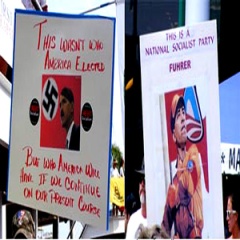 So two days ago music mogul Russell Simmons shocked the world when he announced that him and Dreamworks and a number of other media partners had formed a new movie company called All Def Digital... A few hours after that announcement Russell then tweeted that folks should peep a new project that he found ‘hilarious’. That project was a ‘sextape diary’ of freedom fighter Harriet Tubman..
So two days ago music mogul Russell Simmons shocked the world when he announced that him and Dreamworks and a number of other media partners had formed a new movie company called All Def Digital... A few hours after that announcement Russell then tweeted that folks should peep a new project that he found ‘hilarious’. That project was a ‘sextape diary’ of freedom fighter Harriet Tubman..
In what was deemed a parody with the actress playing Harriet Tubman, dressed up to look like Aunt Jemima. Tubman is shown seducing her slave master while another slave hiding in the closet films her having wild and wanton sex.. She then is supposed to Blackmail the slave master unless he allows her to run the underground railroad..Needless to say folks flipped out and went after Russell like there was no tomorrow..
Within two or three hours Russell had all copies of the video removed and has since been apologizing. Yesterday he sat down with TV One’s News One Network to explain his position. You can peep that story at http://newsone.com/2683757/russell-simmons-harriet-tubman-interview/
Russell also announced that he has since been in touch with descendents of Harriet Tubman, personally apologized to them and agreed to work with them on a documentary about her life..Below is the News One Interview..
http://www.youtube.com/watch?v=TnwDKcpc1RE
As Russell gets underway with working on this documentary, folks may wanna familiarize themselves with Harriet Tubman and the Underground Railroad.. Here’s a couple of pieces that folks may find helpful..
http://www.youtube.com/watch?v=vJqEbMlkb_I
Here’s a documentary on Harriet Tubman called Quest for Freedom
http://www.youtube.com/watch?v=o1zYjh8UA60

 One film that is frequently mentioned is
One film that is frequently mentioned is  The plot of Spook Who Sat by the Door goes as follows.. The CIA because of politics needs to recruit African-Americans to the agency. It’s supposed to be dog and pony show. In other words have Blacks try out for the agency, make it public, but have them fail. However, there was one guy, named Dan Freeman who played the role of an ‘Uncle Tom’ when in real life he was a Black nationalist.. He gets into the CIA, soaks up all their game and then leads an armed rebellion..This fim was so controversial, that it was banned from movie theaters and was hard to get up until recently..
The plot of Spook Who Sat by the Door goes as follows.. The CIA because of politics needs to recruit African-Americans to the agency. It’s supposed to be dog and pony show. In other words have Blacks try out for the agency, make it public, but have them fail. However, there was one guy, named Dan Freeman who played the role of an ‘Uncle Tom’ when in real life he was a Black nationalist.. He gets into the CIA, soaks up all their game and then leads an armed rebellion..This fim was so controversial, that it was banned from movie theaters and was hard to get up until recently.. Another flick building on the Slave revolt theme is the Legend of Nigger Charley and Soul of Nigger Charley featuring Fred Williamson. It focuses on a trio of escaped slaves who are down to fight and win against white oppressors.. Believe it or not when these films came out there were posters all over subways in NYC advertising the film. The N word was not covered or changed.. It was very much in your face.. Legend of Nigger Charley went on to be Paramount pictures highest grossing film in 1972 when it was released.
Another flick building on the Slave revolt theme is the Legend of Nigger Charley and Soul of Nigger Charley featuring Fred Williamson. It focuses on a trio of escaped slaves who are down to fight and win against white oppressors.. Believe it or not when these films came out there were posters all over subways in NYC advertising the film. The N word was not covered or changed.. It was very much in your face.. Legend of Nigger Charley went on to be Paramount pictures highest grossing film in 1972 when it was released.
 Loving this new jam called ‘Genocide Highway’ from M1 of
Loving this new jam called ‘Genocide Highway’ from M1 of 













